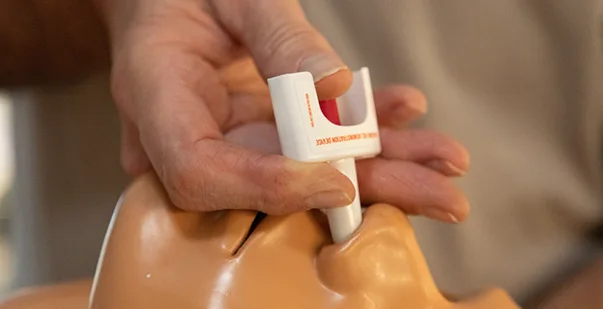Table Of Content(s)
- Introduction
- What are the naloxone administration routes?
- What are the properties of Naloxone as a drug?
- Steps to follow when someone overdoses on opioid
- Important Considerations While Administering Naloxone
- How can Basic Life Support Training Help with Medication Administration?
- Conclusion
Opioid overdoses are emergencies where every second counts. In such critical moments, naloxone can make a significant difference. Knowing how to administer this life saving drug is a key skill in BLS (Basic Life Support) training.
According to several studies, administration of Naloxone on time can reduce mortality by up to 93%. That’s a staggering number! The faster the drug is delivered, the better the outcome for the patient. In this blog, we will explore the common administration routes for Naloxone. We will also understand the pros and cons of each method. Without further delay, let’s begin-
Master BLS Now
Get BLS certified with confidence
What are the Naloxone administration routes?
Speed and precision while administering Naloxone can make the difference between life and death. Naloxone primarily has four administration routes. Let’s go through them one at a time:
Nasal Spray (Intranasal)
- Easy to administer without needles
- Ideal for use by bystanders and non-medical professionals
- Works quickly to reverse opioid effects
Intramuscular Injection
- Requires a syringe and needle
- Often used by medical personnel and first responders
- Can be injected into the thigh, upper arm, or buttocks
Intravenous (IV) Injection
- Fastest-acting method
- Typically used in hospital or emergency settings
- Requires professional training for administration
Subcutaneous Injection
- Slower absorption than intramuscular or IV methods
- Administered under the skin, often in medical settings
Read More: How To Put BLS Certification On Resume
What are the properties of Naloxone as a drug?
Naloxone is an opioid antagonist. It rapidly reverses the effects of opioid overdose, particularly respiratory depression. Naloxone works by blocking opioid receptors in the brain.
These are the key properties of Naloxone:
- Fast-Acting: Quickly reverses opioid effects, often within minutes.
- Short Duration: Effects last 30-90 minutes, so additional doses may be required.
- Non-Addictive: No potential for abuse or addiction.
- Minimal Side Effects: Generally safe, but may cause withdrawal symptoms in opioid-dependent individuals.
- Widely Available: Can be administered by both medical professionals and laypersons, often available without a prescription.
Steps To Follow When Someone Overdoses On Opioid
When someone overdoses on opioids, taking immediate action can save their life. Here are the key steps to follow:
- Call for Emergency Help (911)
- Always seek medical assistance first.
- Provide the operator with as much detail as possible.
- Check for Responsiveness
- Try to wake the person by shaking them or calling their name.
- If unresponsive, proceed to the next steps.
- Administer Naloxone
- Use a Naloxone nasal spray or injection as per the instructions.
- If there’s no response after 2-3 minutes, administer a second dose.
- Perform Rescue Breathing or CPR(Cardiopulmonary Resuscitation)
- If the person isn’t breathing, provide rescue breaths.
- If trained, begin CPR if their heart has stopped.
- Monitor the Person’s Condition
- Stay with them until help arrives.
- If they wake up, encourage them to stay calm and still, as opioid withdrawal may occur.
- Be Prepared to Administer More Naloxone
- Naloxone’s effects may wear off before the opioids do, so be ready to give another dose if needed.
Read More: 4 Levels of EMT Certification: EMR, EMT, AEMT & Paramedic
Important Considerations While Administering Naloxone
Administering naloxone in an opioid overdose emergency can be a lifesaving intervention. But it is important to keep a few considerations in mind to ensure the opration’s efficiency.
While administering Naloxone in Basic Life Support, keep these things in mind:
Timeliness is Critical
- Administer Naloxone as soon as you suspect an overdose, as delayed intervention can increase the risk of permanent damage or death.
Multiple Doses May Be Needed
- The effects of Naloxone may wear off before the opioids do, so be prepared to administer another dose if the person relapses into unresponsiveness.
Watch for Withdrawal Symptoms
- Naloxone can trigger immediate opioid withdrawal symptoms like agitation, sweating, and nausea, especially in opioid-dependent individuals.
Naloxone Does Not Replace Medical Help
- Even after administering Naloxone, always call 911. The person will need professional medical evaluation and further care.
Proper Administration Method
- Ensure you are familiar with the specific Naloxone product you have (nasal spray or injection) and follow the instructions for correct use.
Safe Handling
- Keep Naloxone stored in a cool, dry place and check expiration dates regularly to ensure its effectiveness in emergencies.
How can Basic Life Support Training Help with Medication Administration?
Basic Life Support (BLS) training equips individuals with essential life-saving skills. This includes management of cardiac arrests, choking and opioid overdoses. Let’s find out BLS training can help with medicine administration in opioid overdose:
- BLS training teaches the correct administration techniques for medications like Naloxone. This drug is used during opioid overdoses, and epinephrine for severe allergic reactions.
- Trainees learn to identify medical emergencies where medication is necessary. They stay prepared for respiratory depression or anaphylaxis. This allows for quick and appropriate action.
- BLS-trained individuals can assist medical professionals by administering emergency medications before advanced care arrives.
- Tools like auto-injectors and Naloxone nasal sprays are taught to be used in BLS classes. This increases both efficiency and confidence.
Conclusion
Understanding the common routes for Naloxone is important for anyone who is trained in BLS (Basic Life Support). Whether it’s an injection or in the form of a nasal spray, knowing each of these methods are important. Each of the routes offer a rapid and effective way to reverse opioid overdose. By being familiar with these options, you can act quickly and confidently. Opt for a BLS class today and make the difference in critical hours.







